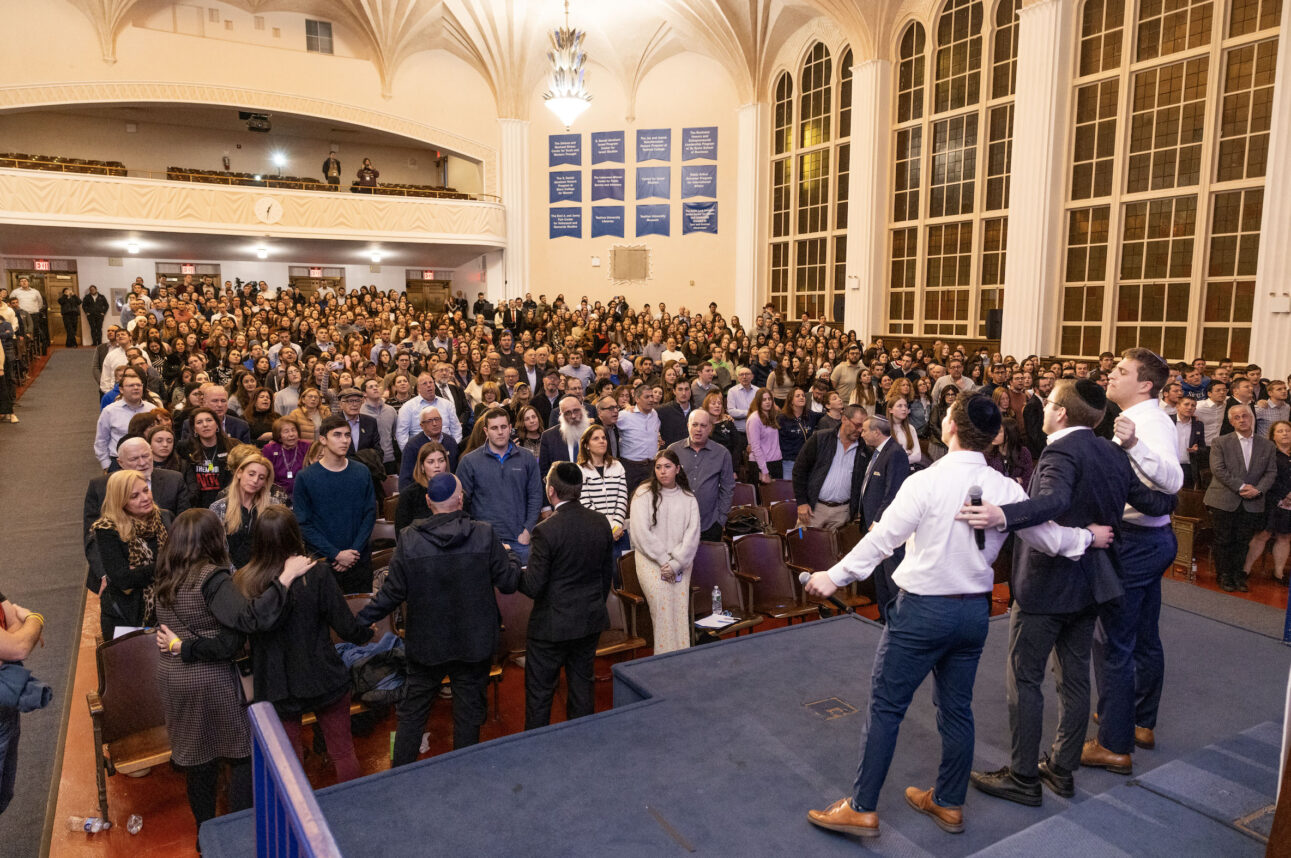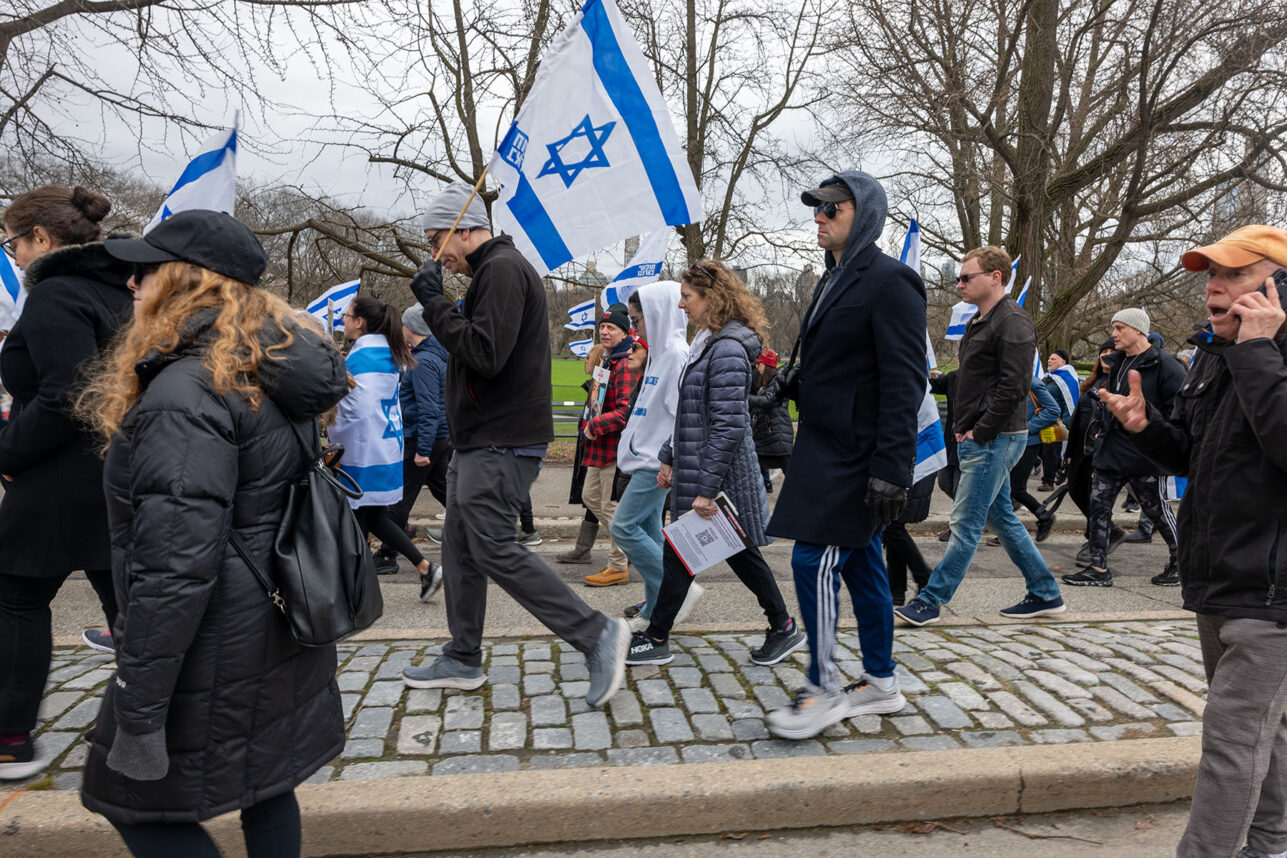 The rock fusion band Ollin performs at the opening of the “From Brooklyn Ave to Cesar Chavez” exhibition at Breed Street Shul in Boyle Heights. Photos by David Wu
The rock fusion band Ollin performs at the opening of the “From Brooklyn Ave to Cesar Chavez” exhibition at Breed Street Shul in Boyle Heights. Photos by David Wu In the predominantly Latino, Christian neighborhood of Boyle Heights today, the Breed Street Shul normally is a lonely sight, empty and locked away behind a chain-link fence topped with barbed wire. The onetime Jewish community emigrated west decades ago.
But on June 4, a small gaggle chatted out front and klezmer music drifted into the street. Blue and yellow balloons floating at the imposing brick facade helped announce the opening of a UCLA exhibition bringing to life once more the neighborhood’s Jewish past.
For some who attended the shul when it still functioned, the event served as a homecoming of sorts.
“This is really weird, that people are interested in the Breed Street Shul again — it’s great,” said Vicky Esquenazi Bharier, whose family moved to the neighborhood in the early 1960s from Cuba.
The exhibition marks a temporary return of Jewish life to the East Los Angeles neighborhood that, in the 1930s, was the focal point of the city’s Jewry. Innumerable bar mitzvahs, weddings and funeral services took place in the Breed Street Shul and the synagogues that dotted the area. But as the European immigrants who made up the majority of the community began to establish themselves and become wealthier, they moved west.
Today, the neighborhood is more than 80 percent Mexican. But the decades of Jewish presence in Boyle Heights left an impact on the minds and hearts of its onetime residents, and the exhibition aims to bring those memories into focus.
“From Brooklyn Ave to Cesar Chavez: Jewish Histories in Multiethnic Boyle Heights” will run through Aug. 31 in the synagogue (breedstreetshul.org), which is in the process of restoration. The exhibition’s name is a play on the area’s main drag, steps away from the synagogue — Avenida Cesar Chavez, whose name changed from Brooklyn Avenue in 1994.
While the exhibition opened at UCLA’s Royce Hall in November 2016, the June 4 opening marked the first time it was available to the public in the neighborhood it celebrates. Laid out on top of an enlarged historic map of the neighborhood, the exhibition includes not only timelines and informational placards but also class photographs and personal artifacts, such as a jersey from a local boys club, the Jasons.
“The exhibit really springs from the community,” Todd Presner, director of the UCLA Alan D. Leve Center for Jewish Studies, which hosts the exhibition, said at the opening.
The display draws on artifacts from the Hinda and Jacob Schonfeld Boyle Heights Collection at UCLA, which Presner said aims “to collect materials, memories, scrapbooks, photographs, letters — anything that you have that really documents the vitality and history of the neighborhood.”
For the visitors who grew up in the neighborhood, the exhibition’s content wasn’t history, but living memory. For instance, one of the displays showed the onetime Jewish Community Center on Michigan Avenue and Soto Street. Arlene Feingold, 83, who attended the opening, recalled playing Beethoven’s “Für Elise” at the community center during a piano recital when she was a child.
Alan D. Leve, the donor for whom the Jewish studies center is named, also attended the opening. His childhood took place largely between St. Louis Street and Soto Street along Brooklyn Avenue, he said.
“That was my world,” he told the Journal in an earlier interview. “And I just remember it was a bustling community.”
“That’s our great thrill as historians: When you give people something to connect to, to relate to, that they can see themselves reflected in,” said Caroline Luce, a research and digital projects manager at the Jewish studies center and one of the main architects of the exhibition.
The venue itself is a reflection of the neighborhood’s Jewish history. A clapboard structure set behind the brick building that houses the main sanctuary, it is the older — if less impressive — of the two buildings that make up the historic site, built in 1915. The larger and grander main sanctuary building, dating to 1923, remains under construction, closed for now, pending seismic retrofits.
Back in its heyday, the clapboard building that houses the exhibition used to host three morning prayer groups, with the earliest, the Bakers’ Minyan, starting around 4 a.m. to accommodate the bakers’ early schedules, according to Stephen Sass, president of the Jewish Historical Society of Southern California.
By the 1990s, the shul was in dire need of rehabilitation. Rival gangs had claimed it as their territory, and it served as a shelter for prostitutes and drug dealers, Sass said. Two decades and millions of dollars in renovations later, the building now serves intermittently as event space for local groups and the occasional bar mitzvah.
“It’s gone through a lot of work so that you’re able to be here,” Sass told the crowd that gathered for the exhibition opening. “I’m the most proud, I think, not just of this beautiful mural which surrounds the holy ark, the Aron Kodesh, but of the fact that we have working restrooms.”
The event aimed to showcase not just Jewish narratives in Boyle Heights, but also the histories of the other communities that coexisted there. In 1930, records show that people from 40 nationalities lived in the neighborhood, according to Luce.
“Jewish history is always in contact with other histories,” Presner said.
Hence, the exhibition featured not just the Mt. Sinai Home for Incurables and The Workmen’s Circle, but also the Southern California Japanese Hospital and the United Farm Workers.
The event also featured musical performances varying across time and culture, including the UCLA Klezmer Ensemble as well as the local rock fusion band Ollin.
“We watched the neighborhood change from Brooklyn Avenue to Chavez,” said Scott Rodarte, the front man for Ollin. “We’ve been around. History is never kind to this neighborhood, so we’re proud that light has been shed on its faith.”
But it was the klezmer performance that captured the event’s major theme.
As the klezmer band played, Sass walked to the center of the room and offered Luce a handkerchief. She took it and they began to dance, the handkerchief connecting them, feet stamping as the crowd watched and clapped to the beat. If only for the moment, Jewish life had returned to Boyle Heights.
“From Brooklyn Ave to Cesar Chavez: Jewish Histories in Multiethnic Boyle Heights” is open 11 a.m. to 4 p.m. Mondays and Wednesdays, and on Sundays by appointment. For more information, visit this story at jewishjournal.com.






















 More news and opinions than at a Shabbat dinner, right in your inbox.
More news and opinions than at a Shabbat dinner, right in your inbox.